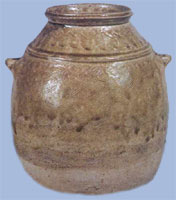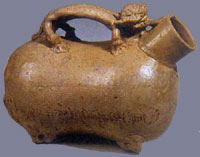|
China, Brilliance of Early Chinese Porcelain
Verily mature celadon porcelain first appeared in late of the Eastern Han Dynasty (AD25-220). This sort of porcelain was first discovered in Xiaoxiantai, Shangyu County, Zhejiang Province. It is glazed completely, and the glazing layer became thicker. It has quite strong luster and transparency, and the coalescence between the glaze and its base is compact and firm. Bowl, saucer, plate, canister, open-top cup, basin, kettle, circular pod and vase are utensils commonly seen. They were mainly decorated with raised line design and water-wave design. When it came to the Three Kingdoms (historical time AD 220-280), the base of celadon porcelain became harder and appeared pale grey with more even glaze. In addition, the coalescence of base and glaze became closer; the decoration of design became richer. The common decoration of design includes raised line design, water-wave design, animal head applique and sloped check design. In respect of base shape, there appeared chicken head ewer, chamber pot, sheep-shape receptacle and frog-shape spittoon, and so forth. Starting from middle of the Dong Jin Dynasty (historical time AD 317-420), producing of celadon porcelain became more popular; shape of porcelain became more simplified; and the decoration reduced greatly, mainly raised line design. In late of Dongjin Dynasty, lotus leaf as decoration came into sight and spread rapidly.
Celadon Glaze Woven Design Canister

Produced in the Eastern Han Dynasty (historical time AD 25-220), 19.4 cm in height, collected by Shanghai History Museum. Features: short mouth and folded lip, empty part a bit protruding, flat bottom; base fine and smooth, solid and compact; glaze bluish-yellow and thinner; glaze of external wall not reaches bottom and appears tear stains; two circles of water design engraved on shoulder; woven design on belly wall; simple as well as decent.
Celadon Glaze Chamber Pot
 Produced in the Wu Empire (AD 222-280) of the Three Kingdoms (AD 220-265), 15.7 cm in height and 20.9 cm in length, the piece is collected by China History Museum. Chamber Pot is a kind of common celadon porcelain as funeral objects discovered in tombs of the Six Dynasties (AD 222-589), it is said to be a sort of water utensil while someone else considers it as urinary utensil, named for its outer appearance similar to a fallen tiger. The features of this Chamber Pot: corpulent body and a bit constrictive middle waist, a slope and strait circular mouth on front-upper; a mouth-open and head-lift beast handle on its back, the beast opens eyes and looks far away with four standing claws like a fierce couchant tiger desired to jump, and the gesture thereof is vivid and lifelike. Produced in the Wu Empire (AD 222-280) of the Three Kingdoms (AD 220-265), 15.7 cm in height and 20.9 cm in length, the piece is collected by China History Museum. Chamber Pot is a kind of common celadon porcelain as funeral objects discovered in tombs of the Six Dynasties (AD 222-589), it is said to be a sort of water utensil while someone else considers it as urinary utensil, named for its outer appearance similar to a fallen tiger. The features of this Chamber Pot: corpulent body and a bit constrictive middle waist, a slope and strait circular mouth on front-upper; a mouth-open and head-lift beast handle on its back, the beast opens eyes and looks far away with four standing claws like a fierce couchant tiger desired to jump, and the gesture thereof is vivid and lifelike.
Unsophisticated and Magnificent Primal Celadon Porcelain
When the wind and dew of autumn arrive, Yue Kiln is open and overwhelms the emerald of thousand mountains
|